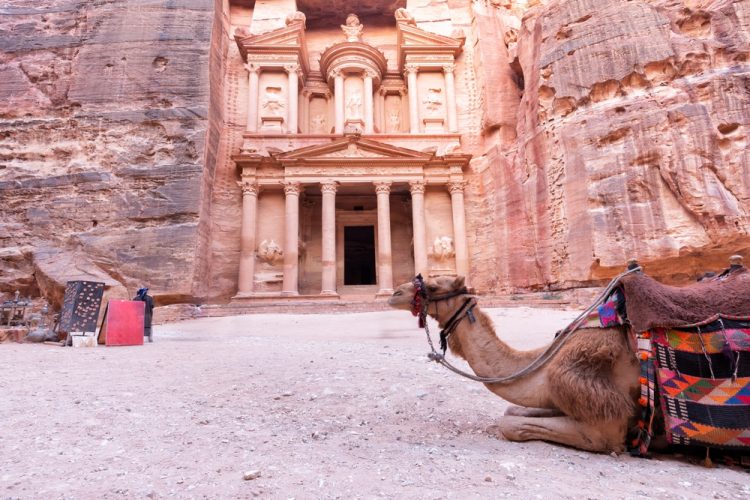Often referred to as the Rose-Red City, Petra stands among the deserts and mountains of Jordan as a legacy frozen in time. Carved from a wall of sandstone within the Great Rift Valley, the first sight of the 130-foot facade and its intricate designs and columns conjure up an ancient home for those long gone. A place of majesty and mystery, Petra holds a place in the coveted New 7 Wonders of the World.
A History Set in Stone
Petra was founded in the 4th century BCE by the Nabataeans. It was built in a perfect position along an ancient incense trading route, making it a hub for trade between Arabia, Egypt, and the Levant* (what is now known as Lebanon, Syria, Jordan, Israel, and Palestine). The Nabataeans, a nomadic Arab people, settled here and carved a thriving city into rose-colored cliffs. Their engineering feats included aqueducts, dams, and reservoirs, allowing Petra to flourish in the middle of the desert.
Petra eventually fell under Roman rule and was largely abandoned after several devastating earthquakes. It remained hidden to the Western world until its rediscovery in 1812 by Swiss explorer Johann Ludwig Burckhardt. Today, Petra is a UNESCO World Heritage Site and a symbol of Jordan’s rich and layered history. Travelers can explore this past through tours that bring Petra’s ancient grandeur into sharp focus alongside other historic highlights.
The Geography of Awe
Petra is located in southern Jordan, about 150 miles south of Amman. The entrance to the city is through a narrow gorge called the Siq — a dramatic sandstone corridor nearly a mile long. Walking through its winding path, flanked by cliffs that tower over 260 feet high, visitors finally emerge before Al-Khazneh, the Treasury — Petra’s most famous monument.
Petra’s terrain is rugged and expansive, covering over 100 square miles. Hidden trails lead to the Monastery, the Royal Tombs, and panoramic lookout points like the High Place of Sacrifice. The best time to explore is during the spring (March to May) or fall (September to November), when the weather is mild and the desert sun is gentler.
Culture and Continuity
Although Petra is often viewed through the lens of archaeology, it is also a living cultural site. The B’doul Bedouins, who once made their homes in Petra’s caves, continue to serve as stewards of the land. Their presence is felt in the marketplace stalls, the scent of mint tea, and stories shared beneath desert stars.
Visitors can participate in cultural experiences such as a cooking class at Petra Kitchen, where local chefs teach traditional Jordanian recipes like mansaf and magloubeh. Nighttime brings its own kind of magic as an atmospheric walk through the candlelit Siq culminating in a musical performance at the Treasury.
A Journey Through Time, Today
Petra’s beauty lies not only in its grandeur, but in its silence — in the moments between footsteps where time seems to pause in lingering past. Petra, in all its dimensions: past, present and timeless, offers more than just a photo opportunity — it offers perspective.

